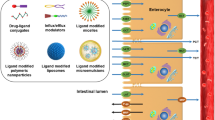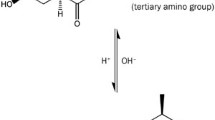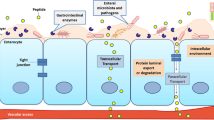Abstract
Purpose
We have previously reported that Capryol 90 improves the intestinal absorption of insulin, a peptide drug, without causing serious damage to the intestinal epithelium. However, the effects of Capryol 90 and its related formulations on the intestinal absorption of other drugs, and their absorption-enhancing mechanisms are still unclear. The aim of this study is to evaluate the effects of Capryol 90 and its related formulations on the intestinal absorption of drugs and elucidate their absorption-enhancing mechanisms.
Methods
The intestinal absorption of 5(6)-carboxyfluorescein, fluorescein isothiocyanate-dextrans, and alendronate was evaluated using an in situ closed loop method. Brush border membrane vesicles (BBMVs) were labeled with fluorescent probes, and the fluidity of membrane was evaluated by a fluorescence depolarization method. The expression levels of tight junction (TJ) proteins were measured using a Western blot method and immunofluorescence staining.
Results
Among the tested excipients, Capryol 90 significantly improved the small and large intestinal absorption of drugs. In mechanistic studies, Capryol 90 increased the membrane fluidity of lipid bilayers in BBMVs. Additionally, Capryol 90 decreased the expression levels of TJ-associated proteins, namely claudin-4, occludin, and ZO-1.
Conclusions
Capryol 90 is an effective absorption enhancer for improving the intestinal absorption of poorly absorbed drugs via both transcellular and paracellular pathways.








Similar content being viewed by others
References
Drucker DJ. Advances in oral peptide therapeutics. Nat Rev Drug Discov. 2020;19(4):277–89.
Kaur G, Arora M, Ravi Kumar MNV. Oral drug delivery technologies—a decade of developments. J Pharmacol Exp Ther. 2019;370(3):529–43.
Sachdeva S, Lobo S, Goswami T. What is the future of noninvasive routes for protein- and peptide-based drugs? Ther Deliv. 2016;7(6):355–7.
Aguirre TAS, Teijeiro-Osorio D, Rosa M, Coulter IS, Alonso MJ, Brayden DJ. Current status of selected oral peptide technologies in advanced preclinical development and in clinical trials. Adv Drug Deliv Rev. 2016;106:223–41.
Cao S jun, Xu S, Wang H ming, et al. Nanoparticles: Oral delivery for protein and peptide drugs. AAPS PharmSciTech. 2019;20(5):190.
Maher S, Casettari L, Illum L. Transmucosal absorption enhancers in the drug delivery field. Pharmaceutics. 2019;11(7):339.
Maher S, Mrsny RJ, Brayden DJ. Intestinal permeation enhancers for oral peptide delivery. Adv Drug Deliv Rev. 2016;106:277–319.
Hu Z, Tawa R, Konishi T, Shibata N, Takada K. A novel emulsifier, Labrasol, enhances gastrointestinal absorption of gentamicin. Life Sci. 2001;69(24):2899–910.
Prasad YVR, Minamimoto T, Yoshikawa Y, et al. In situ intestinal absorption studies on low molecular weight heparin in rats using Labrasol as absorption enhancer. Int J Pharm. 2004;271(1–2):225–32.
McCartney F, Jannin V, Chevrier S, Boulghobra H, Hristov DR, Ritter N, et al. Labrasol® is an efficacious intestinal permeation enhancer across rat intestine: ex vivo and in vivo rat studies. J Control Release. 2019;310:115–26.
Ukai H, Iwasa K, Deguchi T, Morishita M, Katsumi H, Yamamoto A. Enhanced intestinal absorption of insulin by Capryol 90, a novel absorption enhancer in rats: implications in oral insulin delivery. Pharmaceutics. 2020;12(5):462.
Ukai H, Kawagoe A, Sato E, Morishita M, Katsumi H, Yamamoto A. Propylene glycol caprylate as a novel potential absorption enhancer for improving the intestinal absorption of insulin: efficacy, safety, and absorption-enhancing mechanisms. J Pharm Sci. 2020;109(4):1483–92.
Bhor VM, Sivakami S. Regional variations in intestinal brush border membrane fluidity and function during diabetes and the role of oxidative stress and non-enzymatic glycation. Mol Cell Biochem. 2003;252(1–2):125–32.
Ganapathy V, Mendicino JF, Leibach FH. Transport of glycyl-L-proline into intestinal and renal brush border vesicles from rabbit. J Biol Chem. 1981;256(1):118–24.
Prabhu R, Balasubramanian KA. A novel method of preparation of small intestinal brush border membrane vesicles by polyethylene glycol precipitation. Anal Biochem. 2001;289(2):157–61.
Stiger B, Murer H. Heterogeneity of brush-border-membrane vesicles from rat small intestine prepared by a precipitation method using Mg/EGTA. Eur J Biochem. 1983;135(1):95–101.
Vázquez CM, Zanetti R, Ruiz-Gutierrez V. Lipid composition and fluidity in the jejunal brush-border membrane of spontaneously hypertensive rats. Effects on activities of membrane-bound proteins. Biosci Rep. 1996;16(3):217–26.
Seth A, Sheth P, Elias BC, Rao R. Protein phosphatases 2A and 1 interact with occludin and negatively regulate the assembly of tight junctions in the CACO-2 cell monolayer. J Biol Chem. 2007;282(15):11487–98.
Wong JA, Renton KW, Crocker JFS, O’Regan PA, Acott PD. Determination of pamidronate in human whole blood and urine by reversed-phase HPLC with fluorescence detection. Biomed Chromatogr. 2004;18(2):98–101.
Drake MT, Clarke BL, Khosla S. Bisphosphonates: mechanism of action and role in clinical practice. Mayo Clin Proc. 2008;83(9):1032–45.
Eiken P, Vestergaard P. Treatment of osteoporosis after alendronate or risedronate. Osteoporos Int. 2016;27(1):1–12.
Graham DY. What the gastroenterologist should know about the gastrointestinal safety profiles of bisphosphonates. Dig Dis Sci. 2002;47(8):1665–78.
Naniwa T, Maeda T, Mizoshita T, Hayami Y, Watanabe M, Banno S, et al. Alendronate-induced esophagitis: possible pathogenic role of hypersensitivity to alendronate. Intern Med. 2008;47(23):2083–5.
Yamamoto A, Taniguchi T, Rikyuu K, Tsuji T, Fujita T, Murakami M, et al. Effects of various protease inhibitors on the intestinal absorption and degradation of insulin in rats. Pharm Res. 1994;11(10):1496–500.
Lin Y, Fujimori T, Kawaguchi N, Tsujimoto Y, Nishimi M, Dong Z, et al. Polyamidoamine dendrimers as novel potential absorption enhancers for improving the small intestinal absorption of poorly absorbable drugs in rats. J Control Release. 2011;149(1):21–8.
Numata N, Takahashi K, Mizuno N, Utoguchi N, Watanabe Y, Matsumoto M, et al. Improvement of intestinal absorption of macromolecules by nitric oxide donor. J Pharm Sci. 2000;89(10):1296–304.
Fetih G, Habib F, Okada N, Fujita T, Attia M, Yamamoto A. Nitric oxide donors can enhance the intestinal transport and absorption of insulin and [Asu1,7]-eel calcitonin in rats. J Control Release. 2005;106(3):287–97.
Kajii H, Horie T, Hayashi M, Awazu S. Fluorescence study of the membrane-perturbing action of sodium caprylate as related to promotion of drug absorption. J Pharm Sci. 1988;77(5):390–2.
Yoon BK, Jackman JA, Kim MC, Sut TN, Cho NJ. Correlating membrane morphological responses with micellar aggregation behavior of capric acid and monocaprin. Langmuir. 2017;33(11):2750–9.
Li X, Uehara S, Sawangrat K, Morishita M, Kusamori K, Katsumi H, et al. Improvement of intestinal absorption of curcumin by cyclodextrins and the mechanisms underlying absorption enhancement. Int J Pharm. 2018;535(1–2):340–9.
Sawangrat K, Yamashita S, Tanaka A, Morishita M, Kusamori K, Katsumi H, et al. Modulation of intestinal transport and absorption of topotecan, a BCRP substrate, by various pharmaceutical excipients and their inhibitory mechanisms of BCRP transporter. J Pharm Sci. 2019;108(3):1315–25.
Yamashita S, Furubayashi T, Kataoka M, Sakane T, Sezaki H, Tokuda H. Optimized conditions for prediction of intestinal drug permeability using Caco-2 cells. Eur J Pharm Sci. 2000;10(3):195–204.
Gumbiner BM. Breaking through the tight junction barrier. J Cell Biol. 1993;123(6 II):1631–3.
Goodenough DA. Plugging the leaks. Proc Natl Acad Sci U S A. 1999;96(2):319–21.
Turner JR, Buschmann MM, Romero-Calvo I, Sailer A, Shen L. The role of molecular remodeling in differential regulation of tight junction permeability. Semin Cell Dev Biol. 2014;36:204–12.
Morita K, Furuse M, Fujimoto K, Tsukita S. Claudin multigene family encoding four-transmembrane domain protein components of tight junction strands. Proc Natl Acad Sci U S A. 1999;96(2):511–6.
Rahner C, Mitic LL, Anderson JM. Heterogeneity in expression and subcellular localization of claudins 2, 3, 4, and 5 in the rat liver, pancreas, and gut. Gastroenterology. 2001;120(2):411–22.
Furuse M, Hirase T, Itoh M, et al. Occludin: A novel integral membrane protein localizing at tight junctions. J Cell Biol. 1993;123(6 II):1777–88.
Rao R. Occludin phosphorylation in regulation of epithelial tight junctions. Ann N Y Acad Sci. 2009;1165:62–8.
Tsukita S, Katsuno T, Yamazaki Y, Umeda K, Tamura A, Tsukita S. Roles of ZO-1 and ZO-2 in establishment of the belt-like adherens and tight junctions with paracellular permselective barrier function. Ann N Y Acad Sci. 2009;1165:44–52.
Han X, Zhang E, Shi Y, Song B, Du H, Cao Z. Biomaterial-tight junction interaction and potential impacts. J Mater Chem B. 2019;7(41):6310–20.
Hsu LW, Lee PL, Chen CT, Mi FL, Juang JH, Hwang SM, et al. Elucidating the signaling mechanism of an epithelial tight-junction opening induced by chitosan. Biomaterials. 2012;33(26):6254–63.
Tomita M, Hayashi M, Awazu S. Absorption-enhancing mechanism of EDTA, caprate, and decanoylcarnitine in Caco-2 cells. J Pharm Sci. 1996;85(6):608–11.
González-Mariscal L, Tapia R, Chamorro D. Crosstalk of tight junction components with signaling pathways. Biochim Biophys Acta Biomembr. 2008;1778(3):729–56.
Chen T, Berenson J, Vescio R, Swift R, Gilchick A, Goodin S, et al. Pharmacokinetics and pharmacodynamics of zoledronic acid in cancer patients with bone metastases. J Clin Pharmacol. 2002;42(11):1228–36.
Uludag H. Bisphosphonates as a foundation of drug delivery to bone. Curr Pharm Des. 2002;8(21):1929–44.
Declarations of Interest
None
Funding
This research did not receive any specific grant from funding agencies in the public, commercial, or not-for-profit sectors.
Author information
Authors and Affiliations
Corresponding author
Additional information
Publisher’s Note
Springer Nature remains neutral with regard to jurisdictional claims in published maps and institutional affiliations.
Rights and permissions
About this article
Cite this article
Ukai, H., Imanishi, A., Kaneda, A. et al. Absorption-Enhancing Mechanisms of Capryol 90, a Novel Absorption Enhancer, for Improving the Intestinal Absorption of Poorly Absorbed Drugs: Contributions to Trans- or Para-Cellular Pathways. Pharm Res 37, 248 (2020). https://doi.org/10.1007/s11095-020-02963-0
Received:
Accepted:
Published:
DOI: https://doi.org/10.1007/s11095-020-02963-0




